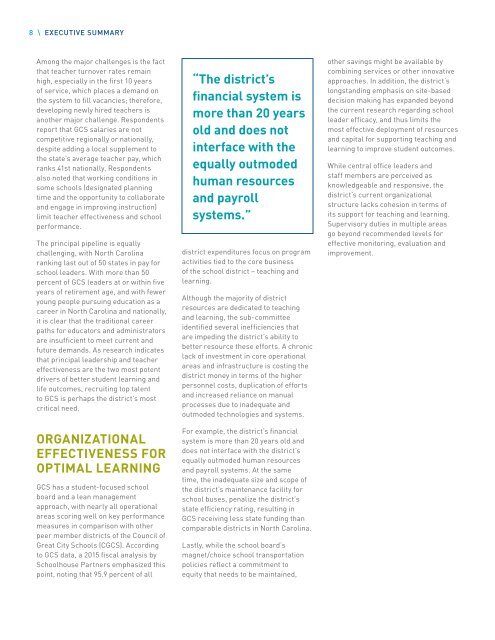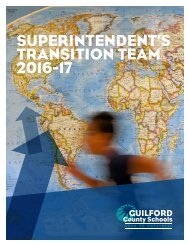Transition Team 2016-17 Final Report
Create successful ePaper yourself
Turn your PDF publications into a flip-book with our unique Google optimized e-Paper software.
8 \ EXECUTIVE SUMMARY<br />
Among the major challenges is the fact<br />
that teacher turnover rates remain<br />
high, especially in the first 10 years<br />
of service, which places a demand on<br />
the system to fill vacancies; therefore,<br />
developing newly hired teachers is<br />
another major challenge. Respondents<br />
report that GCS salaries are not<br />
competitive regionally or nationally,<br />
despite adding a local supplement to<br />
the state’s average teacher pay, which<br />
ranks 41st nationally. Respondents<br />
also noted that working conditions in<br />
some schools (designated planning<br />
time and the opportunity to collaborate<br />
and engage in improving instruction)<br />
limit teacher effectiveness and school<br />
performance.<br />
The principal pipeline is equally<br />
challenging, with North Carolina<br />
ranking last out of 50 states in pay for<br />
school leaders. With more than 50<br />
percent of GCS leaders at or within five<br />
years of retirement age, and with fewer<br />
young people pursuing education as a<br />
career in North Carolina and nationally,<br />
it is clear that the traditional career<br />
paths for educators and administrators<br />
are insufficient to meet current and<br />
future demands. As research indicates<br />
that principal leadership and teacher<br />
effectiveness are the two most potent<br />
drivers of better student learning and<br />
life outcomes, recruiting top talent<br />
to GCS is perhaps the district’s most<br />
critical need.<br />
ORGANIZATIONAL<br />
EFFECTIVENESS FOR<br />
OPTIMAL LEARNING<br />
GCS has a student-focused school<br />
board and a lean management<br />
approach, with nearly all operational<br />
areas scoring well on key performance<br />
measures in comparison with other<br />
peer member districts of the Council of<br />
Great City Schools (CGCS). According<br />
to GCS data, a 2015 fiscal analysis by<br />
Schoolhouse Partners emphasized this<br />
point, noting that 95.9 percent of all<br />
“The district’s<br />
financial system is<br />
more than 20 years<br />
old and does not<br />
interface with the<br />
equally outmoded<br />
human resources<br />
and payroll<br />
systems.”<br />
district expenditures focus on program<br />
activities tied to the core business<br />
of the school district – teaching and<br />
learning.<br />
Although the majority of district<br />
resources are dedicated to teaching<br />
and learning, the sub-committee<br />
identified several inefficiencies that<br />
are impeding the district’s ability to<br />
better resource these efforts. A chronic<br />
lack of investment in core operational<br />
areas and infrastructure is costing the<br />
district money in terms of the higher<br />
personnel costs, duplication of efforts<br />
and increased reliance on manual<br />
processes due to inadequate and<br />
outmoded technologies and systems.<br />
For example, the district’s financial<br />
system is more than 20 years old and<br />
does not interface with the district’s<br />
equally outmoded human resources<br />
and payroll systems. At the same<br />
time, the inadequate size and scope of<br />
the district’s maintenance facility for<br />
school buses, penalize the district’s<br />
state efficiency rating, resulting in<br />
GCS receiving less state funding than<br />
comparable districts in North Carolina.<br />
Lastly, while the school board’s<br />
magnet/choice school transportation<br />
policies reflect a commitment to<br />
equity that needs to be maintained,<br />
other savings might be available by<br />
combining services or other innovative<br />
approaches. In addition, the district’s<br />
longstanding emphasis on site-based<br />
decision making has expanded beyond<br />
the current research regarding school<br />
leader efficacy, and thus limits the<br />
most effective deployment of resources<br />
and capital for supporting teaching and<br />
learning to improve student outcomes.<br />
While central office leaders and<br />
staff members are perceived as<br />
knowledgeable and responsive, the<br />
district’s current organizational<br />
structure lacks cohesion in terms of<br />
its support for teaching and learning.<br />
Supervisory duties in multiple areas<br />
go beyond recommended levels for<br />
effective monitoring, evaluation and<br />
improvement.



